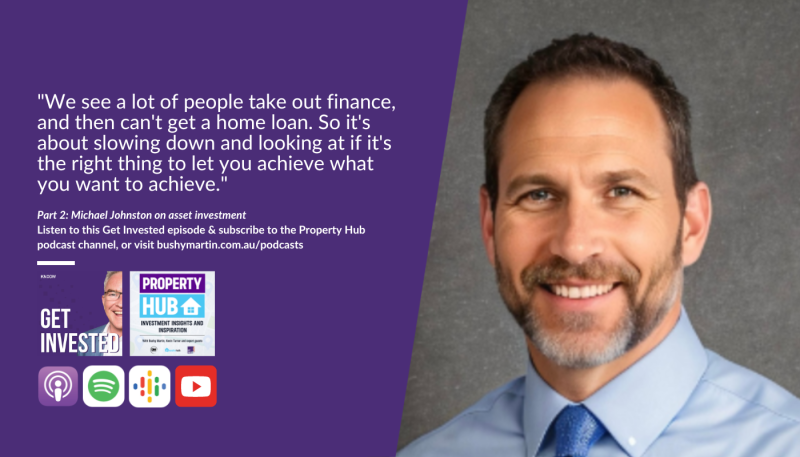Michael Johnston says there are benefits for investors who finance their assets, as opposed to buying outright.
The Director of National Direct Finance and a top asset finance broker, Michael joined KnowHow’s Bushy Martin on Property Hub’s Get Invested podcast to talk about the best processes and questions for investors to ask when considering financing an asset.
Why finance an asset versus buying it outright
Michael explained financing an asset provides greater flexibility and the ability for investors to direct some of their funds towards other assets or investments.
“It leaves money in the bank for you to use to do other things. And then ideally, if you’re taking out finance, you’ve got some tax benefit for doing it. So that’s worthwhile if you’re using a car for work or if you’ve got a business and then you can write the car off,” he said.
“But ultimately, I guess it just comes down to if you’re going to pay $50,000 or $30,000 for a car, could that $30,000 be used better somewhere else in conjunction with you taking out finance? So you also don’t want to take out finance if you need to borrow money, and by taking that finance out it’s going to reduce your ability or your level of borrowing to do the investment or the income generating loan that you want to take out. So if it’s properly understood, then that financing does make sense.”
What questions to ask when considering financing an asset
Investors should take a more strategic approach when looking at their overall situation, understanding why they’re buying an asset and ensuring it’s in their best interests.
“Buying a vehicle is a very emotive thing. So we like to slow that process down a little bit, just to make sure you’re getting the right thing. It gives you the ability to just double check what you’re doing and ask, am I financing that over the right period of time? How long am I going to keep the car for, and is the structure, that I’ve been spoken to about by the dealership, really the right one that’s going to suit me for the future?” Michael said.
“So we ask what do you want to do? Yes you’re doing this asset finance, but what are you going to do in five years time or three years time? Are you buying more property or are you investing in some other way? Do you have a wedding to pay for? Outside of the car, what do you need to use this money for? We see a lot of people take out finance, and then can’t get a home loan, or vice versa. So it’s about slowing down, looking at what you’re doing and if it’s the right thing to let you achieve what you want to achieve.”
Why it is about much more than just interest rates
Michael said the biggest mistake investors make is solely focusing on the rate without understanding the impact of other factors upon minimum repayments.
“The interest rates are probably the smallest part of the equation that you need to focus on, and they probably have the least impact on payments. Now that’s assuming when you’re talking about interest rates, you’re talking maybe a difference of 2%. If you’re talking 10% to 35%, then clearly straight up there’s a difference. However, if you’re trying to compare something that’s 2%, then the lowest interest rate may not be the cheapest payment,” he said.
“So sometimes people get a little concerned that I’m trying to take them away from the interest rate conversation because that’s what they know, but we’re trying to educate people on understanding what the true cost is. So outside of the interest rates, what are the other costs added into the finance that aren’t and don’t have to be reflected in the rate, that are going to make the overall cost a lot more. So we need to make sure people understand that when they compare, so they compare the right things. So ultimately it’s about how much is it going to cost you opposed to the interest rate, because you can’t buy anything with an interest rate.”
Bushy added: “It’s very similar in the home loan environment where banks and a lot of brokers focus on the lowest rate. But when you look at the ingoing, ongoing, outgoing fees, and then the impact of offset accounts and other exercises that you can bring to the table to influence what the true bottom like cost it, when you compare that on an apples for apples basis with other alternatives, then suddenly you’re having a very different conversation. And while rate is part of it, it is only part of it”.
Listen to the full interview here.
Want to Know How you can build wealth and optimise your property finance with the help of leading, qualified experts? Check us out and talk to the team, now.




